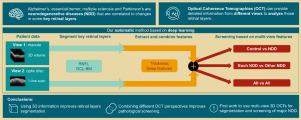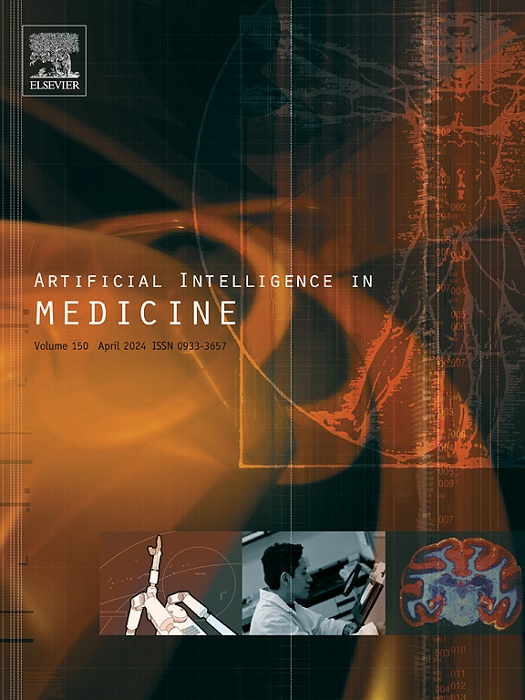利用多视角 OCT 图像筛查神经退行性疾病的全自动深度卷积方法
IF 6.1
2区 医学
Q1 COMPUTER SCIENCE, ARTIFICIAL INTELLIGENCE
引用次数: 0
摘要
随着人口老龄化的加剧,神经退行性疾病(NDDs),如阿尔茨海默氏症(AD)、帕金森氏症(PD)、原发性震颤(ET)和多发性硬化症(MS)的发病率也在不断上升。最近的研究表明,这些疾病可以通过视网膜成像进行识别,从而通过光学相干断层扫描(OCT)进行早期检测和监测。这项研究走在研究前沿,率先将多视角光学相干断层扫描和三维信息应用于神经疾病领域。我们的方法包括两个主要步骤。第一步,我们重点关注黄斑和视盘 OCT 扫描中视网膜神经纤维层(RNFL)的分割以及神经节细胞层和布鲁氏膜之间的类层分组(GCL-BM)。这些区域的厚度变化可作为 NDD 的潜在指标。第二阶段是根据视网膜层的信息选择患者。我们探讨了两种视图(黄斑和视盘)的整合如何改善每种筛选方案:健康对照组 (HC) vs. NDD、AD vs. NDD、ET vs. NDD、MS vs. NDD、PD vs. NDD,以及最后一种考虑所有四种 NDD 的多类方法。在黄斑分割任务中,二维和三维方法都取得了令人满意的结果,其中三维方法由于包含了深度和横截面信息而表现更好。至于视盘视图,与从头开始训练相比,迁移学习并没有改善指标,但它确实提供了更快的训练。在筛查方面,三维计算生物标志物比二维生物标志物提供了更好的结果,多视角方法通常比单视角方法更好。关于疾病之间的可分离性,多发性硬化症和帕金森病是筛选方法中结果较好的疾病,也是代表性最强的类别。总之,通过对配置、技术和 OCT 视图的广泛实验,我们的方法得到了成功的验证,成为首个融合了以黄斑为中心和以视盘为中心的数据的多视图分析方法。此外,这也是首次在病理筛查框架内对四种主要 NDD 的关键视网膜层进行检查。本文章由计算机程序翻译,如有差异,请以英文原文为准。

Fully automatic deep convolutional approaches for the screening of neurodegeneratives diseases using multi-view OCT images
The prevalence of neurodegenerative diseases (NDDs) such as Alzheimer’s (AD), Parkinson’s (PD), Essential tremor (ET), and Multiple Sclerosis (MS) is increasing alongside the aging population. Recent studies suggest that these disorders can be identified through retinal imaging, allowing for early detection and monitoring via Optical Coherence Tomography (OCT) scans. This study is at the forefront of research, pioneering the application of multi-view OCT and 3D information to the neurological diseases domain. Our methodology consists of two main steps. In the first one, we focus on the segmentation of the retinal nerve fiber layer (RNFL) and a class layer grouping between the ganglion cell layer and Bruch’s membrane (GCL-BM) in both macular and optic disc OCT scans. These are the areas where changes in thickness serve as a potential indicator of NDDs. The second phase is to select patients based on information about the retinal layers. We explore how the integration of both views (macula and optic disc) improves each screening scenario: Healthy Controls (HC) vs. NDD, AD vs. NDD, ET vs. NDD, MS vs. NDD, PD vs. NDD, and a final multi-class approach considering all four NDDs. For the segmentation task, we obtained satisfactory results for both 2D and 3D approaches in macular segmentation, in which 3D performed better due to the inclusion of depth and cross-sectional information. As for the optic disc view, transfer learning did not improve the metrics over training from scratch, but it did provide a faster training. As for screening, 3D computational biomarkers provided better results than 2D ones, and multi-view methods were usually better than the single-view ones. Regarding separability among diseases, MS and PD were the ones that provided better results in their screening approaches, being also the most represented classes. In conclusion, our methodology has been successfully validated with an extensive experimentation of configurations, techniques and OCT views, becoming the first multi-view analysis that merges data from both macula-centered and optic disc-centered perspectives. Besides, it is also the first effort to examine key retinal layers across four major NDDs within the framework of pathological screening.
求助全文
通过发布文献求助,成功后即可免费获取论文全文。
去求助
来源期刊

Artificial Intelligence in Medicine
工程技术-工程:生物医学
CiteScore
15.00
自引率
2.70%
发文量
143
审稿时长
6.3 months
期刊介绍:
Artificial Intelligence in Medicine publishes original articles from a wide variety of interdisciplinary perspectives concerning the theory and practice of artificial intelligence (AI) in medicine, medically-oriented human biology, and health care.
Artificial intelligence in medicine may be characterized as the scientific discipline pertaining to research studies, projects, and applications that aim at supporting decision-based medical tasks through knowledge- and/or data-intensive computer-based solutions that ultimately support and improve the performance of a human care provider.
 求助内容:
求助内容: 应助结果提醒方式:
应助结果提醒方式:


